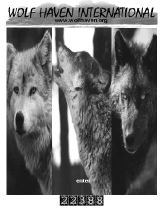The wolf plays a unique, and rather villainous, role in American mythology. In folk tales he lurks in the shadiest part of the woods, awaiting Little Red Riding Hood. In horror movies he undergoes a supernatural transformation from the innocent mortal into the hairy, blood-lusting wolf man. He has sunk his fangs into our language: The outcast is a “lone wolf,” the gluttonous are those who “wolf down” their food. Yet these negative images overshadow the wolf’s purpose in the food chain. No, we wouldn’t want to stumble upon him in a dark forest, what with his jaws capable of exerting 1,500 pounds per square inch. But this predator plays a key role in keeping larger members of the animal kingdom—deer, elk, caribou—in check, while removing the sick and weaker animals.
Founded in 1982, Wolf Haven International was formed by a group of individuals alarmed that wolves—particularly gray wolves—had themselves become the sick and the weak. Due to damage done by government bounties and fur trading in the late 1800s and early 1900s, by the 1950s wolves had disappeared from 99 percent of their range within the lower 48 United States. In 1974, they suddenly appeared on the Endangered Species list. Fortunately, Wolf Haven’s early alarm has quieted to concern. Wolf Haven conservation coordinator Tami Williams views 19th-century massacres as “ancient history” and happily reports that the wolf population is on the rise—and the prowl—once again.
“Working for wolf conservation” is Wolf Haven’s mission statement, and in addition to providing a home for captive-born gray wolves—those who lived previously in zoos or medical labs or people’s homes—the 20-acre Haven is currently breeding Mexican gray wolves for introduction into the wild. A highly endangered subspecies of the gray wolf, Mexican wolves receive shelter at Wolf Haven until the age of two, when they’re shipped south of the border. While Mexican wolves also receive shelter from the public eye, Wolf Haven tours offer rare glimpses into the private lives of gray wolves (little did we know the “lone wolf” actually dislikes being alone and shares an enclosure with at least one other canine comrade). Wolf Haven also provides educational workshops and programs to help the public better understand these creatures and the kind of environment they thrive in.
As visitors and members, your dollars go directly to supporting this local sanctuary, and if you want to reach out even farther to our formerly vilified friends, you can adopt one (or more) of them. Sorry, you won’t be able to bring B.B. Wolf (that’s Big Beautiful, not Big Bad) home for holiday dinner with Grandma, but for only $25 you will receive a 4 x 6 color photo of him or her, an adoption certificate, and a brief biography. If you’re not so sure you’re ready to allow a wolf into your own personal pack, visit the residents of Wolf Haven on weekends this winter from 10 to 4 ($6, $5 seniors, $4 kids 3-5). Their howls just might pierce your heart.
Wolf Haven International: 3111 Offut Lake Rd, Tenino, WA 98589, 800-448-9653, www.wolfhaven.org.








